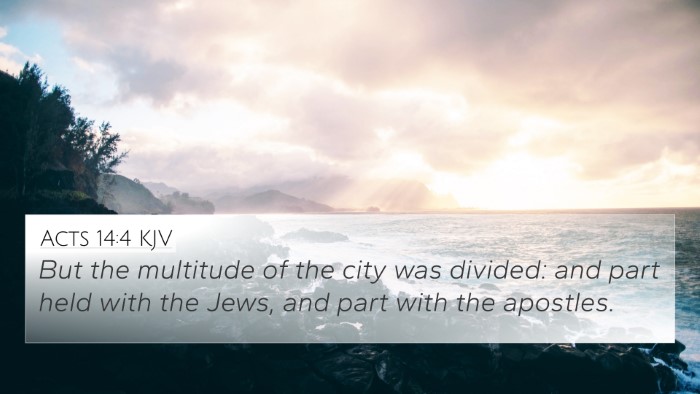Bible Verse Meaning of John 10:19
John 10:19 states: "There was a division therefore again among the Jews for these sayings." This verse highlights the polarized reactions to Jesus' teachings, demonstrating a fundamental conflict of beliefs among the people. This passage can be understood through various public domain commentaries, providing a rich tapestry of interpretation and insight.
Summary of Interpretations
The division mentioned signifies the inability of many to accept Jesus' declarations as the Messiah, leading to intense debates and discord among Jewish leaders and followers. This conflict is portrayed in various commentaries:
-
Matthew Henry:
Henry explains that this division arose because the truths spoken by Jesus challenged the established religious beliefs and practices of the time. He emphasizes that the power of Jesus' words often brings division, separating those who accept Him from those who reject Him.
-
Albert Barnes:
Barnes notes that such divisions were not unusual during Jesus' ministry. He points out that people's responses ranged from awe and reverence to skepticism and hostility, showcasing the stark differences in perception regarding Jesus' identity and mission.
-
Adam Clarke:
Clarke elaborates on the nature of this division, suggesting that it serves as a testament to the profound impact of Christ's teachings. He implies that authentic spirituality often leads to conflict with prevailing norms and ideologies.
Biblical Cross-References
To gain a deeper understanding of John 10:19, it is useful to explore cross-references within the Bible that echo similar themes of division, acceptance, and the nature of Christ's message:
- Matthew 10:34-36: Jesus speaks of bringing a sword, indicating that His message will cause discord even among families.
- Luke 12:51: Similar to Matthew's account, Jesus again asserts that His coming will bring division.
- John 7:43: A prior account of division over Jesus' identity, demonstrating the ongoing conflict during His ministry.
- John 9:16: The division among Pharisees regarding Jesus' miracle provides context to the broader social response to His works.
- Acts 14:4: In the early church, there were similar divisions among the people over the Apostle's preaching.
- 1 Corinthians 1:10: Paul addresses divisions within the church community, reminding believers to be united despite differing views.
- Galatians 5:17: The conflict between the Spirit and the flesh echoes the struggle between accepting Christ and adhering to worldly ways.
Connections Between Bible Verses
This verse, John 10:19, exemplifies broader themes found throughout scripture. Examining connections between Bible verses can reveal the vital thematic elements tying Jesus' ministry to the experience of believers throughout history. Consider:
- Thematic Bible verse connections: The division caused by truth is a recurrent theme, as seen from the Old Testament prophets to the New Testament epistles. The resistance to God's messengers often leads to societal divisions.
- Comparative Bible verse analysis: Evaluating these instances helps understand the cost of discipleship and the challenges believers face in a non-believing world.
- Bible verses that relate to each other: By exploring passages across both Testaments, we realize the continuity of God's message and the persistent, often divisive response from humanity.
Conclusion
In summary, John 10:19 not only reflects the immediate reactions of Jesus' contemporaries but also serves as a lens through which we can examine the division caused by Christian belief across the ages. By utilizing tools for Bible cross-referencing, believers can enhance their understanding of scriptural dialogues, further illuminating the dynamic and sometimes contentious relationship between truth and belief.
Further Study and Reflection
For a comprehensive exploration of these themes, consider employing resources like a Bible concordance or a bible cross-reference guide. Engaging in cross-referencing Bible study methods can deepen your insight into how different passages interconnect and reference each other, ultimately enriching spiritual understanding.










